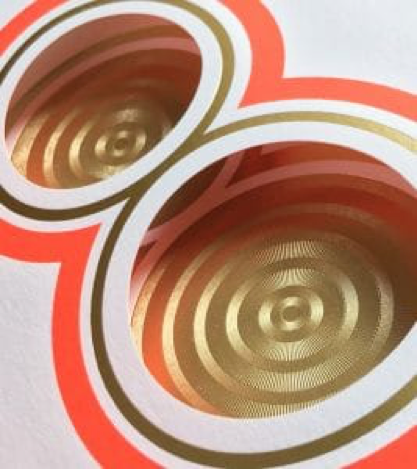Monday, March 9, 2020
A brief introduction to finishing techniques
2020Visual CommunicationDigital printing

"Differentiate yourself with finishing techniques"
Attracting and retaining increasingly connected, demanding, and ever-changing consumers is one of the biggest challenges brands face today. In this ultra-competitive "attention" market, the finishing of printed media is becoming an important seduction weapon. With advances in digital finishing systems and the advantages of personalization, advertisers can now benefit from printing and varnishing in small runs and with very short lead times. This is an opportunity for printers to use these advantages to differentiate themselves with their clients. (Re)discover the great traditional finishing techniques that give printing an extra touch of subtlety...
HOT STAMPING

© Cécile Touati – decanoisette.com
It can be gold, silver, colored, matte, or glossy. Hot stamping has several advantages: it covers, is opaque, and can be applied to the material itself, creating textured effects that give it extra richness. Hot stamping, whether on coated or creative paper, presents a high-end and luxurious character. And when combined with embossing, its effects are amplified.
> TECHNIQUE
A film of colored or metallic pigments is applied hot to the substrate (paper, cardboard, PVC) using a metal plate with a relief pattern. The print can be microstructured and textured, or even molded.
RELIEF ENGRAVING
© Cécile Touati – decanoisette.com
Gaining luminosity, giving paper nuances of volume, playing with purity or sophistication: the embossing technique guarantees elegance and subtlety, whether used alone or combined with hot foil stamping, screen printing, or die-cutting, which amplify its effects. Whether seeking modernity or classicism: embossing can be used freely and is applicable to all types of creations.
> TECHNIQUE
Relief printing involves creating a raised pattern using a deep-engraved cliché and a second relief print, between which the support is placed. The two parts, when pressed together, create a volume through deformation. Textured or multi-level relief printing and embossing (hollow deformation) complete the range of techniques.
SERIGRAPHY

© Cécile Touati – decanoisette.com
Printing vivid, saturated, dense, or fluorescent colors, matte, glossy, or metallic. Applying varnishes that give texture, shine, or volume. All these assets constitute the richness of screen printing, a technique that offers a wide range of applications.
> TECHNIQUE
Screen printing involves applying inks or varnishes to various media (paper, cardboard, PVC, etc.) using a screen (or stencil) of different mesh sizes.
VARNISHING
© Cécile Touati – decanoisette.com
Matte, satin, glossy, colorful, glittery, pearlescent, structured: there's a rich range of varnishes. From the most striking to the most subtle, they offer a wide palette for playing with nuances, creating bold contrasts, testing combinations, mixing, and experimenting with textures. A veritable source of visual and tactile effects.
> TECHNIQUE
Selective varnishes are applied by transfer with a photopolymer relief plate (offset) or through a screen of different meshes (silkscreen), while full varnishes are applied over the entire surface with a rubber roller.
FILMED

© Cécile Touati – decanoisette.com
Matte or glossy, the transparency of film allows for decoration and protection. Moreover, with its silver or gold metallic effects, sometimes featuring a mirror effect, iridescent sheen, or intense color, it offers true creative potential to surfaces that are accomplices of light.
> TECHNIQUE
A bonded, opaque, or transparent film is applied to synthetic and paper substrates. Filming is done by calendering, a process that involves laminating the film between heated cylinders.
Molding

© Cécile Touati – decanoisette.com
The final stages of manufacturing are what define a creation. Cutting, folding, gluing, and assembling are the essential steps to finalize a document. Simple or complex, molding is the result of the project. It reveals its final shape, its originality, its subtleties, its bias. Therefore, care and precision are the key words.
> TECHNIQUES
Molding encompasses the operations that complete the manufacturing process of a project. It includes the steps of cutting, assembling, bending, and gluing.
(Source: Japell Hanser & SAG)
